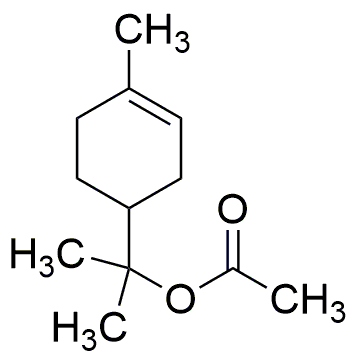Terpinyl acetate is widely utilized in research focused on:
- Fragrance Industry: This compound is a key ingredient in perfumes and scented products due to its pleasant, pine-like aroma, making it popular among fragrance manufacturers.
- Flavoring Agents: It is used as a flavoring agent in food products, providing a citrusy flavor that enhances the taste of various beverages and confections.
- Cosmetics: Terpinyl acetate is incorporated into cosmetic formulations for its fragrance and skin-conditioning properties, appealing to manufacturers aiming for natural and appealing products.
- Pharmaceuticals: The compound is explored for its potential therapeutic properties, particularly in formulations aimed at respiratory health, leveraging its natural origins.
- Industrial Applications: It serves as a solvent in various industrial processes, offering a safer alternative to more toxic solvents, thereby enhancing workplace safety and environmental compliance.
General Information
Properties
Safety and Regulations
Applications
Terpinyl acetate is widely utilized in research focused on:
- Fragrance Industry: This compound is a key ingredient in perfumes and scented products due to its pleasant, pine-like aroma, making it popular among fragrance manufacturers.
- Flavoring Agents: It is used as a flavoring agent in food products, providing a citrusy flavor that enhances the taste of various beverages and confections.
- Cosmetics: Terpinyl acetate is incorporated into cosmetic formulations for its fragrance and skin-conditioning properties, appealing to manufacturers aiming for natural and appealing products.
- Pharmaceuticals: The compound is explored for its potential therapeutic properties, particularly in formulations aimed at respiratory health, leveraging its natural origins.
- Industrial Applications: It serves as a solvent in various industrial processes, offering a safer alternative to more toxic solvents, thereby enhancing workplace safety and environmental compliance.
Documents
Safety Data Sheets (SDS)
The SDS provides comprehensive safety information on handling, storage, and disposal of the product.
Product Specification (PS)
The PS provides a comprehensive breakdown of the product’s properties, including chemical composition, physical state, purity, and storage requirements. It also details acceptable quality ranges and the product's intended applications.
Certificates of Analysis (COA)
Search for Certificates of Analysis (COA) by entering the products Lot Number. Lot and Batch Numbers can be found on a product’s label following the words ‘Lot’ or ‘Batch’.
*Catalog Number
*Lot Number
Certificates Of Origin (COO)
This COO confirms the country where the product was manufactured, and also details the materials and components used in it and whether it is derived from natural, synthetic, or other specific sources. This certificate may be required for customs, trade, and regulatory compliance.
*Catalog Number
*Lot Number
Safety Data Sheets (SDS)
The SDS provides comprehensive safety information on handling, storage, and disposal of the product.
DownloadProduct Specification (PS)
The PS provides a comprehensive breakdown of the product’s properties, including chemical composition, physical state, purity, and storage requirements. It also details acceptable quality ranges and the product's intended applications.
DownloadCertificates of Analysis (COA)
Search for Certificates of Analysis (COA) by entering the products Lot Number. Lot and Batch Numbers can be found on a product’s label following the words ‘Lot’ or ‘Batch’.
*Catalog Number
*Lot Number
Certificates Of Origin (COO)
This COO confirms the country where the product was manufactured, and also details the materials and components used in it and whether it is derived from natural, synthetic, or other specific sources. This certificate may be required for customs, trade, and regulatory compliance.


